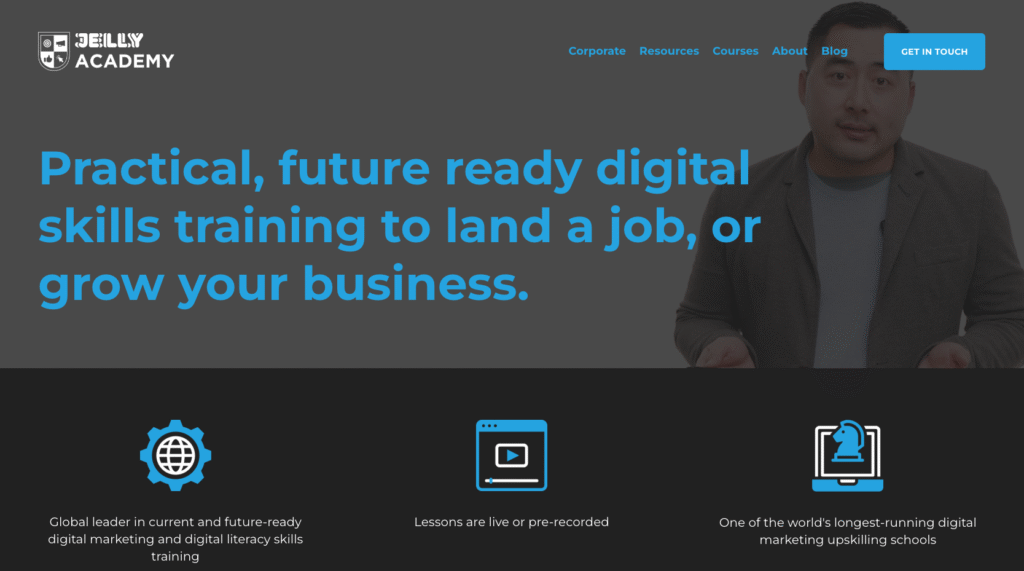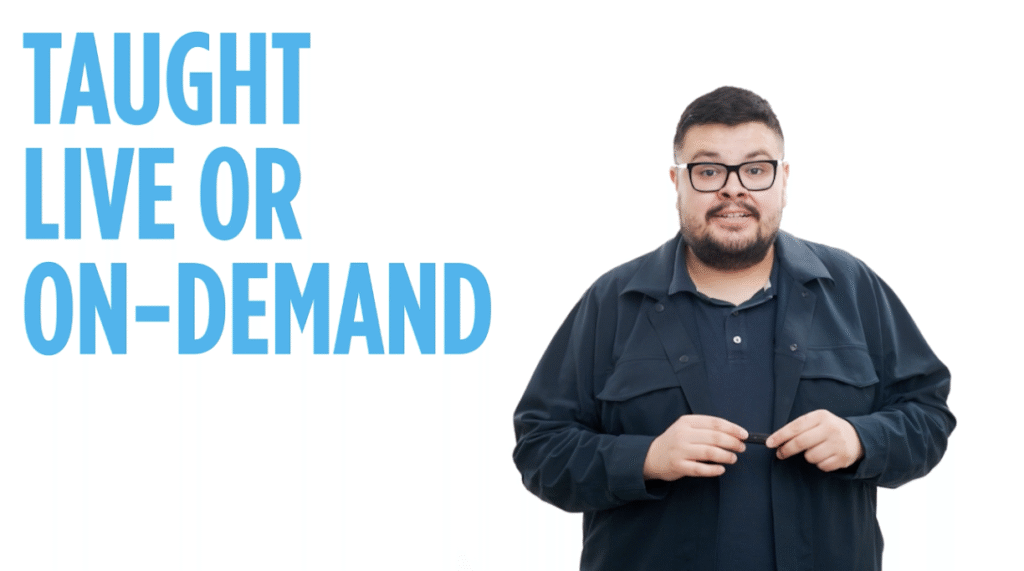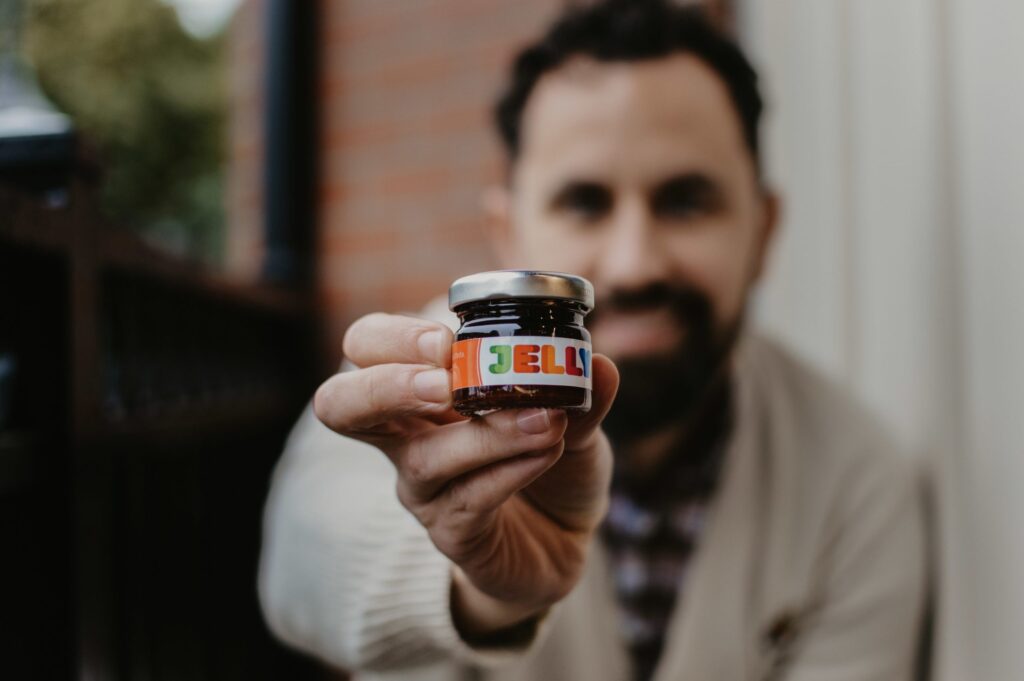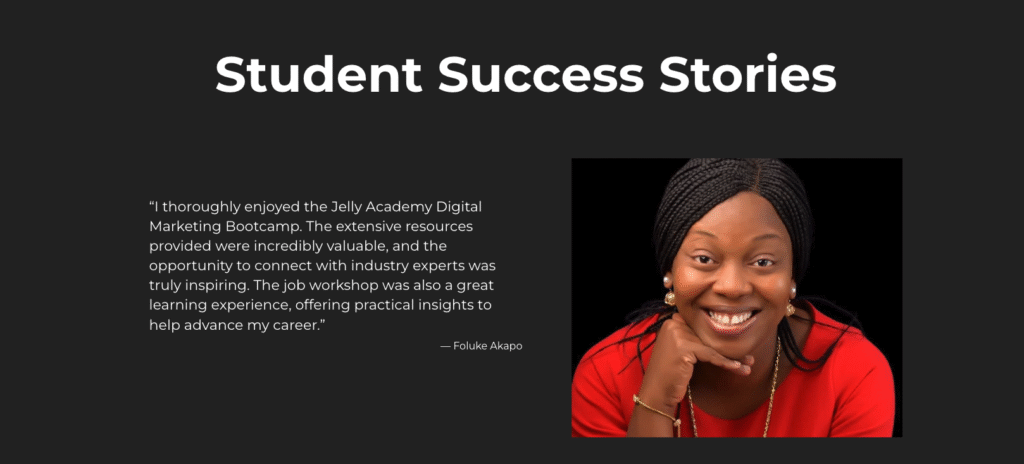8 Ways Jelly Academy Became a Leader in Digital Marketing Training

Meet Jelly Marketing
Darian Kovacs’ career journey began as curriculum developer for a 300-student youth group. There, he stumbled upon an unexpected passion: marketing.
He discovered that running a successful youth group—in his case, for high schoolers—wasn’t just about creating great content. It was about getting people to actually show up. “I was fascinated by learning how to get people to participate,” shares Kovacs. “I loved the marketing side of it.”
Targeting this age group was no easy task. “High schoolers are the hardest to write curriculum for; they have so much going on emotionally and physically,” he continues. “I realized that if you could capture the attention of this age group, you could capture the attention of anyone.”
From then on, every role he took only deepened his sense that marketing was where he belonged. In 2013, he built a 20-person, boutique marketing agency in Fort Langley, BC, called Jelly Marketing. Since, he’s worked with brands like La-Z-Boy Furniture, Spence Diamonds, Lego, 7-Eleven, and more.

Since, he’s worked with brands like La-Z-Boy Furniture, Spence Diamonds, Lego, 7-Eleven, and more. But his marketing career was still unfolding.
Five years into launching his agency, an encounter with a longtime client sparked the idea for a digital marketing school.
She loved what we did for her company, and she wanted to learn how to do some of it herself,” explains Kovac.
Soon, his other clients heard that he was teaching digital marketing and became interested.
“When I met with folks who wanted to hire us, I realized that in some cases—due to the capacity and makeup of their team—they were better off upskilling their internal team in digital marketing versus outsourcing it.” – Darian Kovac, Founder of Jelly Marketing
Building a digital marketing school
From there, Jelly Academy was born. Since 2019, he’s created two learning streams through the Thinkific school: Digital Marketing Bootcamp and Digital Literacy Course—blending hands-on skills with certifications from Google, Meta, and Hootsuite.

In the six years since launching Jelly Academy, his team has taught over 6,000 students with the main goal of reinvesting in the industry and graduating competent, job-ready marketers.
Here’s how he did it:
Sharpening teaching skills in-person before pivoting online
While many experts jump straight to online teaching, Kovacs recommends starting in-person to refine your curriculum through live feedback. “I think the more you can teach real people and get real-time feedback—especially if you’re in an industry that changes often—the better,” he says.
He taught the very first Jelly Academy course at a local school in Langley. This gave him an opportunity to pilot his program—offering it to anyone and everyone. To his delight, 40 students signed up. Riding that momentum, his team partnered with Canada Jobs Grant, a federal program that covers most tuition costs for courses aimed at upskilling staff or boosting a business’s revenue.
As the course gained popularity, his team stumbled upon a roadblock: many people in nearby Vancouver, BC didn’t want to make the hour drive to Langley to take the course. To solve this issue, he moved the program to an online format—first offering it through a series of Zoom calls. “Sometimes people would miss a call, so we thought about sending them recordings or finding a tool to add the recordings and resources,” he shares.
That’s when he found Thinkific. “We realized that this was the best tool for uploading all of our training resources,” he explains.
Developing on-demand learning through Thinkific

At first, Kovacs was hesitant to create prerecorded, on-demand material; he didn’t want the flexible delivery to mean less course completion. However, with growing interest from his students—and their desire for the flexibility to take the course anytime, anywhere—he decided to offer a mix of live and pre-recorded content. Additionally, he provides live office hours, PDFs, guides, quizzes and interactive assignments within the platform.
While many training institutions were fumbling and trying to figure out how to pivot online when covid hit, in 2020 Jelly Academy had already been teaching online for a year. In 2021, they began hosting their course on Thinkific.
“Thanks to Thinkific, we were full speed ahead and able to offer our course nationally in a way that was leaps and bounds above many of our other competitors.”
– Darian Kovac, Founder of Jelly Marketing
Expanding reach through course licensing
Now, Jelly Academy primarily targets four B2C audiences: those re-entering the workforce (like mothers on maternity leave); business owners who want to do their own digital marketing or better understand what they’re outsourcing; recent university grads seeking practical skills to help them land a job; and large brands and agencies aiming to upskill their employees.
On the B2B side, the brand focuses on high schools and post-secondary institutions, such as UBC, Saskatchewan Polytechnic, and Memorial University. In the height of the pandemic, many universities and colleges struggled to adjust quickly to the online world. Jelly Academy was able to license their course to these schools by simply copying and pasting the course and then creating a new edition co-branded with the school.
“We can duplicate our course and have it out the door that same afternoon. Then, when we update all of our content the next quarter, the institution gets a whole new, fresh version of what they’ve licensed.” – Darian Kovac, Founder of Jelly Marketing
The course can be taken through university continuing education departments, often alongside bachelor’s or master’s degrees, as a way to enter the job market. Plus, it’s now offered through grade 12 career development programs across BC and Alberta high schools—whether students are homeschooled or are in a bricks and mortar school. With Thinkific, Kovacs is able to upload course material into one organized, clean place. Additionally, the backend analytics allow his team to track learner progress. “The platform is super streamlined and easy to use,” he explains.

Building credibility through partnerships
Teaching 6,000 students has been possible because of the credibility Jelly Academy has gained through thoughtful partnerships. “I work in an industry that I love and I want people in our profession to be taken seriously,” he says. “When we saw that Google, Meta, and Hootsuite had built these certifications, we wanted to work with them instead of creating one from scratch.”
The academy’s reputation largely comes from being associated with these globally recognized, industry-leading companies.. “Not every agency in Toronto or New York will know your local university, but they all know Meta, Google, and Hootsuite,” continues Kovacs. “You can take a four-year degree that you hope to get a job with, or you can go directly to our course.”
Through working with these partners, he says Jelly Academy is able to hold themselves accountable to a much higher standard—enabling the brand to be on a global stage. “Every single time you sign up for Jelly Academy, we have your certification schedule built into it. Along the way, you graduate with 11 certificates that have all been fully-covered as part of your tuition—making you job-ready.”
Alongside partnering with Google, Meta, and Hootsuite, Jelly Academy’s partnership with universities has been pivotal. In fact, he recommends that other experts consider partnering with secondary and post-secondary institutions, too. “There are still certain parents, grandparents, and employers who care about being educated from a certain name,” he explains. “We’ve been willing and able to partner with and license our course to institutions, building our material into their existing curriculum.”
Reinvesting in the industry rather than chasing profit
Earning respect through these affiliations gave Jelly Academy the freedom to focus on industry growth instead of just revenue.
Kovacs shares that Jelly Academy wasn’t built to be a lucrative business. Instead, it was designed to reinvest in the marketing industry.
“It wasn’t built to be a set-it-and-forget-it course,. It’s always been designed to reinvest and redevelop the industry.”
– Darian Kovac, Founder of Jelly Marketing
He admits there’s a high cost to running the program, updating the curriculum, and hiring skilled instructors. Rather than chasing large profits, Jelly Academy reinvests its earnings to keep the program current. This approach ensures grads receive the latest knowledge while helping clients bring marketing in-house—turning potential lost business into an opportunity for training.
Now, companies like Telus, L’Oréal, Apple, and Airbnb are hiring their grads. “What’s more exciting is that the industry is continuing to standardize—and marketing is being taken more seriously as an industry,” he adds. “It’s like that old saying: a rising tide lifts all boats.”

Updating content every quarter
Most experts are navigating rapidly changing industries, which means content needs regular updates.
In digital marketing—one of the fastest-changing fields—Kovacs makes it a priority to refresh his course every quarter. “The marketing industry changes so much; we have to update our content every quarter,” he reveals. “We couldn’t afford to have an LMS that wasn’t flexible or quickly adjustable.”
He believes that in any constantly evolving industry, you can’t “set it and forget it.”
“Don’t build a course and just throw it out there; if you’re creating a course in an industry that’s constantly changing, you need to be prepared to update and invest in it every quarter.”
To keep pace, he recommends using an LMS like Thinkific because it’s simple to adjust content. “It’s easy to pull out sections and replace them with new stuff, and schedule in refreshments every quarter,” adds Kovacs.
“Thinkific has made it possible to update our content every quarter. It’s nimble and has given us a superpower to create high-quality, fresh content.”
– Darian Kovac, Founder of Jelly Marketing
His other piece of advice: recruit passionate instructors who love what they do, and be open to hiring people who don’t look or talk like you. “It’s inspiring when students see someone who looks like them teaching—especially if they’ve never seen someone like that in a leadership environment,” he notes.
Embodying what he teaches
For Kovacs, staying current isn’t just about updating content—it’s also about staying connected to the work itself.
He gives the example of teaching plumbing. If you’re creating a course on plumbing, he recommends still spending an afternoon a week plumbing. “Keeping a finger on the pulse of what you’re teaching is crucial,” he remarks. “If you’re teaching a coding course, make sure that your staff are still coding and involved in the coding world. We’ve stayed grounded, which has given us an edge.”
He also recommends “holding your course loosely,” meaning make updates and revisions as necessary. “Be willing to not fall in love with the first iteration,” he reflects, “and be open to adjusting and tweaking it.”

Using testimonials as a marketing tool
Beyond course content and teaching, marketing plays a crucial role in Jelly Academy’s ongoing success.
One of their most valuable tools that helps them market Jelly Academy is Story Tap, which helps them gather high-quality video testimonials. “Every time someone finishes our course, we send them a link to create a video testimonial,” he shares. “It’s literally a video director that goes into their inbox and asks them to answer questions.”
These testimonials act as fresh video content that the team can then share on their social media channels, such as their Instagram page.
“It’s more important what others say about you than what you say about yourself. With video testimonials, we get people with different accents, voices, and perspectives talking about our course in an authentic and real way.”
– Darian Kovac, Founder of Jelly Marketing

Reinventing the marketing industry online
For Kovacs, his passion, commitment, and adaptability have paid off in building a successful online program. By partnering with industry leaders and continually updating content, Jelly Academy stays relevant and credible. Plus, his focus on reinvesting in the industry and authentic marketing helps create job-ready graduates that are shaping the future of digital marketing.
Interested in monetizing your knowledge?
Don’t wait to jump online—get started with Thinkific today, for free.
See related Case Studies
-

How American Paint Horse Association Brought Equine Education to the World—and Grew Revenue by 486%
Read more: How American Paint Horse Association Brought Equine Education to the World—and Grew Revenue by 486%Since moving their programs online, American Paint Horse Association has achieved 486% revenue growth, streamlined operations, and expanded its global reach.
-

How Admirato Made Faith-Driven Learning Accessible Globally
Read more: How Admirato Made Faith-Driven Learning Accessible GloballyHow a US-based digital learning company makes high-quality theological education accessible for individuals and groups all around the world.
-

8 Ways Jelly Academy Became a Leader in Digital Marketing Training
Read more: 8 Ways Jelly Academy Became a Leader in Digital Marketing TrainingLearn 8 way that Jelly Academy became a leader in digital marketing training.
